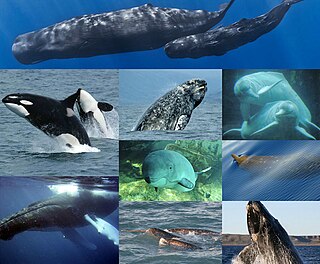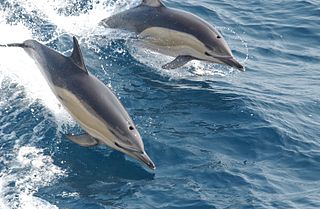Related Research Articles

Cetacea is an infraorder of aquatic mammals belonging to the order Artiodactyla that includes whales, dolphins, and porpoises. Key characteristics are their fully aquatic lifestyle, streamlined body shape, often large size and exclusively carnivorous diet. They propel themselves through the water with powerful up-and-down movement of their tail which ends in a paddle-like fluke, using their flipper-shaped forelimbs to maneuver.

A dolphin is an aquatic mammal within the infraorder Cetacea. Dolphin species belong to the families Delphinidae, Platanistidae, Iniidae, Pontoporiidae, and possibly extinct Lipotidae. There are 40 extant species named as dolphins.

Beaked whales are a family of cetaceans noted as being one of the least-known groups of mammals because of their deep-sea habitat, reclusive behavior and apparent low abundance. Only three or four of the 24 existing species are reasonably well-known. Baird's beaked whales and Cuvier's beaked whales were subject to commercial exploitation, off the coast of Japan, while the northern bottlenose whale was extensively hunted in the northern part of the North Atlantic in the late 19th and early 20th centuries.

The beluga whale is an Arctic and sub-Arctic cetacean. It is one of two members of the family Monodontidae, along with the narwhal, and the only member of the genus Delphinapterus. It is also known as the white whale, as it is the only cetacean to regularly occur with this colour; the sea canary, due to its high-pitched calls; and the melonhead, though that more commonly refers to the melon-headed whale, which is an oceanic dolphin.

Bottlenose dolphins are toothed whales in the genus Tursiops. They are common, cosmopolitan members of the family Delphinidae, the family of oceanic dolphins. Molecular studies show the genus contains three species: the common bottlenose dolphin, the Indo-Pacific bottlenose dolphin, and Tamanend's bottlenose dolphin. Others, like the Burrunan dolphin, may be alternately considered their own species or be subspecies of T. aduncus. Bottlenose dolphins inhabit warm and temperate seas worldwide, being found everywhere except for the Arctic and Antarctic Circle regions. Their name derives from the Latin tursio (dolphin) and truncatus for the truncated teeth.

Whale watching is the practice of observing whales and dolphins (cetaceans) in their natural habitat. Whale watching is mostly a recreational activity, but it can also serve scientific and/or educational purposes. A study prepared for International Fund for Animal Welfare in 2009 estimated that 13 million people went whale watching globally in 2008. Whale watching generates $2.1 billion per annum in tourism revenue worldwide, employing around 13,000 workers. The size and rapid growth of the industry has led to complex and continuing debates with the whaling industry about the best use of whales as a natural resource.

Cetacean intelligence is the overall intelligence and derived cognitive ability of aquatic mammals belonging in the infraorder Cetacea (cetaceans), including baleen whales, porpoises, and dolphins. In 2014, a study found for first time that the long-finned pilot whale has more neocortical neurons than any mammal studied to date, including humans.

Sowerby's beaked whale, also known as the North Atlantic or North Sea beaked whale, is a species of toothed whale. It was the first mesoplodont whale to be described. James Sowerby, an English naturalist and artist, first described the species in 1804 from a skull obtained from a male that had stranded in the Moray Firth, Scotland, in 1800. He named it bidens, which derives from the two teeth present in the jaw, now known to be a very common feature among the genus.

Gervais's beaked whale, sometimes known as the Antillean beaked whale, Gulf Stream beaked whale, or European beaked whale is the most frequently stranding type of mesoplodont whale off the coast of North America. It has also stranded off South America and Africa.

The tropical bottlenose whale, also known as the Indo-Pacific beaked whale or Longman's beaked whale, was considered to be the world's rarest cetacean until recently, but the spade-toothed whale now holds that position. As of 2010, the species is now known from nearly a dozen strandings and over 65 sightings. This is the only species in the genus Indopacetus.

The common dolphin is the most abundant cetacean in the world, with a global population of about six million. Despite this fact and its vernacular name, the common dolphin is not thought of as the archetypal dolphin, with that distinction belonging to the bottlenose dolphin due to its popular appearances in aquaria and the media. However, the common dolphin is often depicted in Ancient Greek and Roman art and culture, most notably in a mural painted by the Greek Minoan civilization.

The northern bottlenose whale is a species of beaked whale in the ziphiid family, being one of two members of the genus Hyperoodon. The northern bottlenose whale was hunted heavily by Norway and Britain in the 19th and early 20th centuries. It is one of the deepest-diving mammals known, reaching depths of 2,339 m (7,674 ft) and capable of diving for up to 130 minutes.

The melon-headed whale, also known less commonly as the electra dolphin, little killer whale, or many-toothed blackfish, is a toothed whale of the oceanic dolphin family (Delphinidae). The common name is derived from the head shape. Melon-headed whales are widely distributed throughout deep tropical and subtropical waters worldwide, but they are rarely encountered at sea. They are found near shore mostly around oceanic islands, such as Hawaii, French Polynesia, and the Philippines.

A dolphinarium is an aquarium for dolphins. The dolphins are usually kept in a pool, though occasionally they may be kept in pens in the open sea, either for research or public performances. Some dolphinariums consist of one pool where dolphins perform for the public, others are part of larger parks, such as marine mammal parks, zoos or theme parks, with other animals and attractions as well.

The River Thames whale, affectionately nicknamed Willy by Londoners, was a juvenile female northern bottlenose whale which was discovered swimming in the River Thames in central London on Friday 20 January 2006. According to the BBC, she was five metres (16-18ft) long and weighed about twelve tonnes (24,400 lb). The whale appeared to have been lost, as her normal habitat would have been around the coasts of the far north of Scotland and Northern Ireland, and in the seas around the Arctic Ocean. It was the first time the species had been seen in the Thames since records began in 1913. She died from convulsions as she was being rescued shortly after 19:00 GMT on 21 January 2006.

British Divers Marine Life Rescue (BDMLR) is a British charity established in 1988 and is a frontline marine mammal response organisation. It utilises a network of trained volunteers around the country to respond to marine mammals potentially in need of assistance via a public 24hr hotline and callout system. The organisation's main areas of operation are in the United Kingdom and its territorial waters; however, the charity has received requests from Canada, the Falkland Islands, Kenya, Ireland, Italy, Kazakhstan, Malta and Abu Dhabi.

The southern bottlenose whale is a species of whale, in the Ziphiid family, one of two members of the genus Hyperoodon. Seldom observed, the southern bottlenose whale is resident in Antarctic waters. The species was first described by English zoologist William Henry Flower in 1882, based on a water-worn skull from Lewis Island, in the Dampier Archipelago, Western Australia. They live in deep ocean waters over 1000 meters.
Cryptid whales are cetaceans claimed to exist by cryptozoologists on the basis of informal sightings, but not accepted by taxonomists as they lack formal descriptions of type specimens. Over the past few hundred years, sailors and whalers have reported seeing whales they cannot identify. The most well-known are Giglioli's Whale, the rhinoceros dolphin, Trunko, the high-finned sperm whale, and the Alula whale.

Whale watching in Ireland is a growing tourism activity. The territorial waters of Ireland have been designated a Whale and Dolphin sanctuary since 1991. In total, 25 different cetacean species have been recorded in Irish waters, with large numbers of cetaceans making seasonal passages off the coastline, and a number of resident populations in coastal harbours and transitional regions.
Cetaceans form an infra-order of marine mammals. In 2020, approximately 86 species of cetaceans had been identified worldwide. Among these species, at least 35 have been sighted in the wider Caribbean region with very widespread distribution and density variations between areas. Caribbean waters are a preferred breeding site for several species of mysticeti, who live further north the rest of the year. The tucuxi and the boto live at the southern periphery of the Caribbean region in the freshwaters of the Amazon River and surrounding drainage basins.
References
- ↑ Griffin, Andrew. "Thames whale - as it happened: Beluga 'Benny' heads further upstream towards London as fears increase". The Independent . Retrieved 26 September 2018.
- ↑ "Thames whale: 'London Delays Work On New $7.5 Billion Thames Tunnel Because Of Benny The Beluga Whale". inquisitr. 19 December 2018. Retrieved 19 December 2018.
- ↑ Sommerlad, Joe. "Why is there an Arctic beluga whale swimming in the Thames?". The Independent .
- ↑ Berg Olsen, Martine (26 September 2018). "Benny the beluga whale spotted swimming in River Thames again". Metro.
- ↑ "Thames whale: 'No major concerns' as beluga moves towards estuary". BBC News. 26 September 2018. Retrieved 26 September 2018.
- ↑ "Thames whale: Benny the beluga spotted slightly upstream". BBC News. 27 September 2018. Retrieved 28 September 2018.
- ↑ "Beluga whale has finally left the Thames, say experts". The Telegraph. The Daily Telegraph. 13 May 2019. Retrieved 13 May 2019.